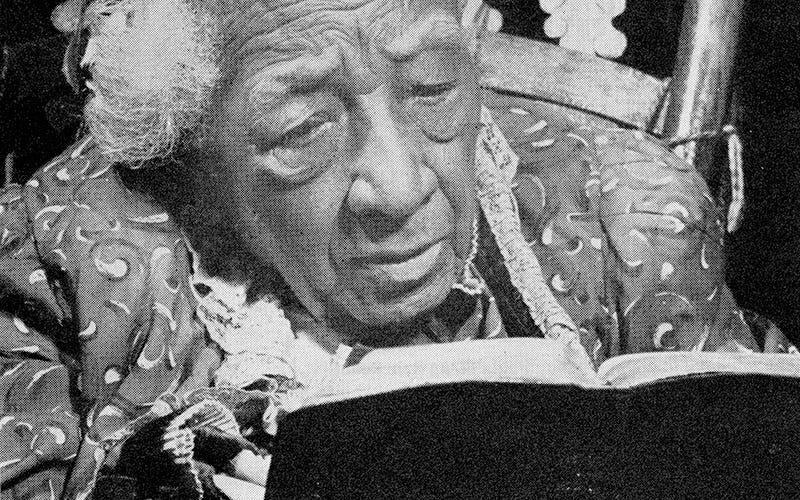Marietta T. Webb: A Pioneer in the Black American Christian Science Movement
Her fervor for Christian Science influenced prominent jazz artists in the 20th-century

When I unexpectedly returned to Christian Science last Summer after a two decade bicoastal romp in the alluring and fraught world of entertainment, I instinctively hit the ground running.
I didn’t know where I was headed but at least I knew it was in the right direction.
I dove back into Mary Baker Eddy’s Science and Health with Key to the Scriptures and Prose Works, read every major Eddy biography, and, along with an esteemed Christian Science colleague, began work on a streaming miniseries about Eddy’s life.
It was during this research when I discovered an inspiring lady who, at the turn of the 20th-century, stood at the precipice of a movement I had no idea even existed: The Black American Christian Science movement.
Note to Reader: When I stumbled on Webb, who I learned was virtually unknown even to seasoned Christian Scientists, I rushed to write up her Wikipedia page — the world over needed a greater chance of happening upon her story, and the fourth most-visited website on the planet seemed a good home. Though I had the choice to alter my Wiki work, ultimately I felt nothing could illuminate the courage and beauty of this woman quite like straightforward facts. Be sure to read her tender words at the end.
Webb was born in Petersburg, VA in 1864, a little over a year after Abraham Lincoln signed the Emancipation Proclamation. She was one of five children, made up of three sons and two daughters.
In 1869, the family relocated to Boston, where Webb received a substantial secondary education. In 1892, she married an engineer named Hiram Webb. They had one child together, Hiram Orlando, who they called "Orlando."
By age four, Orlando suffered from a host of physical maladies, the most serious of which was rickets, a disease that softens and weakens bones in children. Constantly hovering between life and death, physicians pronounced him incurable, saying if he survived he would be an invalid.
In early 1897, Webb was invited by a friend to a Wednesday evening testimony meeting at a nearby church called The First Church of Christ, Scientist, aka "The Mother Church.”
As Webb wrote nine years later in the Christian Science Journal, after attending the meeting, she felt that she had found "the religion for which I had been searching for years."
Webb sought healing help for her son from a Christian Science practitioner, borrowing a copy of Science and Health from a friend. As she began reading, Orlando started improving, and within a week he was able to get up and play.
As she read on, she noticed his limbs growing straighter and stronger, until in less than a month he had fully recovered. Orlando would end up living a natural, healthy life until 1979, when he passed at age 87.
After Orlando’s recovery, Webb said she found Christian Science to be "the only salvation of my race."
In 1907, Mrs. Eddy included Webb's testimony of Orlando's healing in Science and Health.
Webb joined the Christian Science church in 1899. That same year she wrote her first article in The Christian Science Sentinel, called The Protecting Power of Truth, about her allegiance to the "Science of Christianity" and about the "prejudice which exists throughout the United States."
She later wrote that she found Christian Science the basis for "getting out of the old prejudiced self and into the spiritual sense of man’s union with God," and saying that according to Mary Baker Eddy and Science and Health, "I am a child of God, not a colored child of God."
In 1900, Webb relocated her family to Los Angeles, California.
In 1911, at the age of 47, she became one of the first African Americans to be a journal-listed Christian Science practitioner.
In 1934, Webb became a founding member of a Christian Science congregation in East Los Angeles made up of almost entirely Black Americans. The press called her a "world known church worker.”
In 1950, she was the subject of an article in Ebony Magazine featuring Black American Christian Scientists whose numbers had "burgeoned."
Webb's ardent advocacy for Science inspired many Black American jazz artists to join the movement, most notably actor and singer Pearl Bailey, percussionist Lionel Hampton, violinist and conductor Everett Lee, musician Cornelius Bumpus, and singer and composer Blanche Calloway.
Academy award-nominated actor Alfre Woodard has been public about her practice of Christian Science for years.
Marietta T. Webb: In Her Own Words
“It was while Orlando was in what seemed to be his greatest agony, and when I was in the darkest despair, that I first heard of Christian Science. The bearer of the joyful tidings could only tell me to come and hear of the wonderful things that Christian Science was doing. I accepted the invitation, for I was willing to try anything to save my child, and the following Friday evening I attended my first meeting, which was in The Mother Church of Christ, Scientist.”
“I read Science and Health silently and audibly, day and night, in my home, and although I could not seem to understand it, yet the healing commenced to take place at once. The little mouth which had been twisted by spasms grew natural and the child was soon able to be up, playing and romping about the house as any child should.”
“O, glorious Truth that makes us free; that guides us into all the avenues and through all the vicissitudes of life; that is a healing balm for all human complaints; and that protects us from all evil; and which I verily believe is to be the only salvation of my race, the Afro-American, and that it will abolish the prejudice which exists throughout these United States; for, go where we will, we are made to feel our color.”




